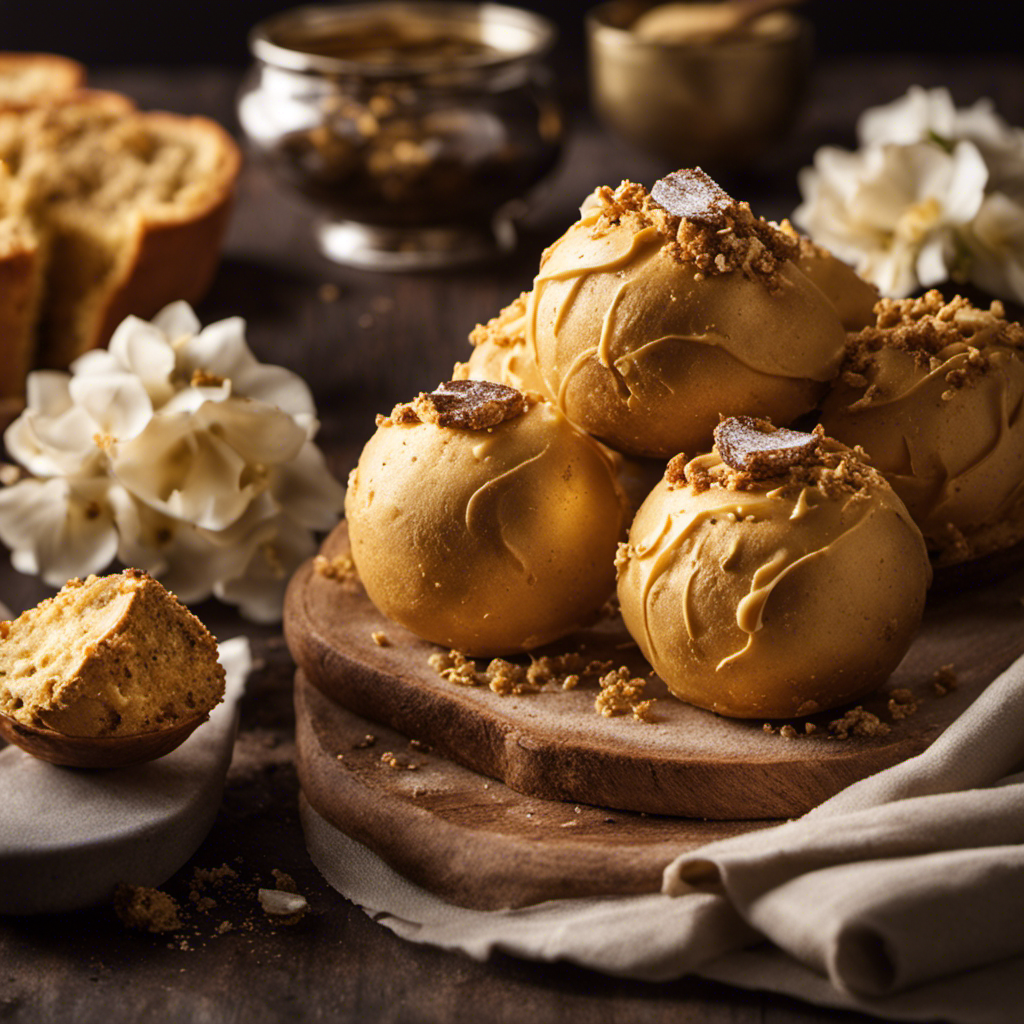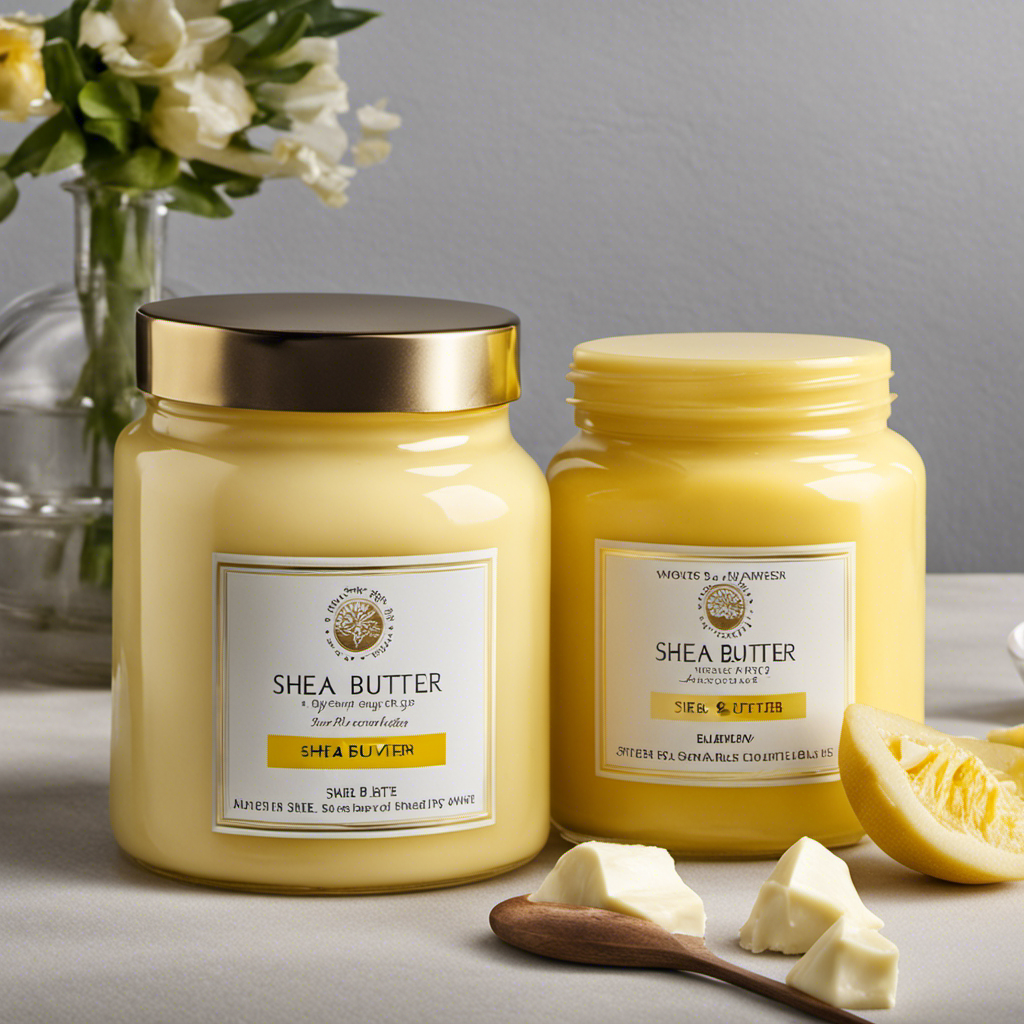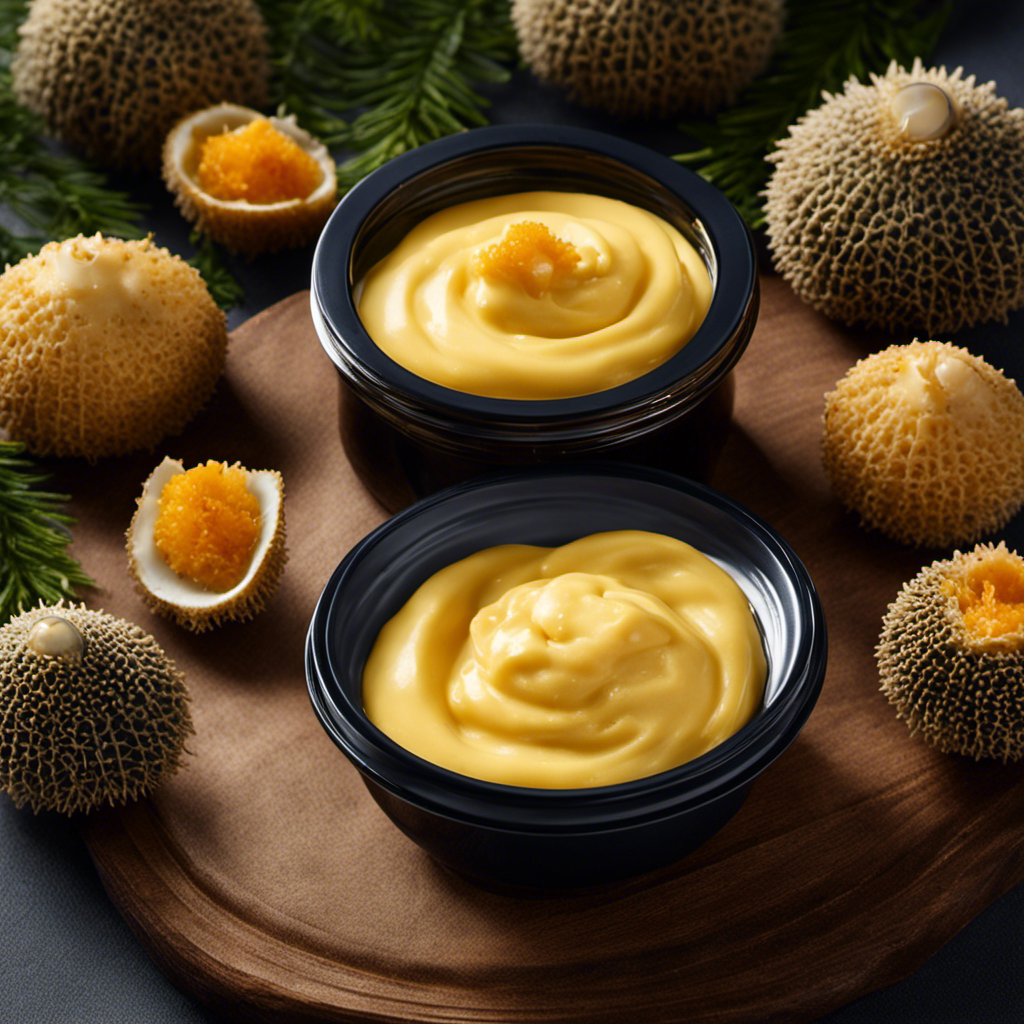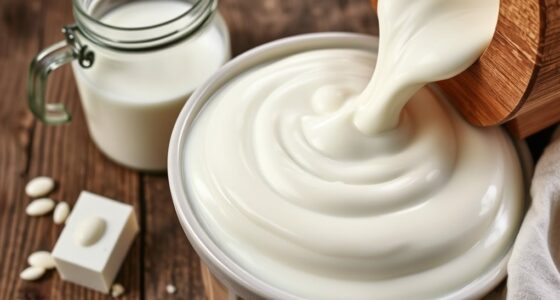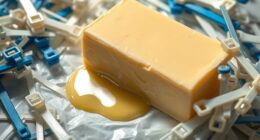As someone who has a strong love for music, I have always been fascinated by the hidden messages found in popular songs.
One song that has piqued my curiosity is ‘Truffle Butter.’ With its catchy beat and intriguing lyrics, it has undoubtedly left many wondering about its true significance.
In this article, we will delve into the depths of this song, analyzing its origins, unraveling the lyrics, and exploring the cultural impact it has had.
Join me on this journey as we uncover the mysteries behind the enigmatic ‘Truffle Butter.’
Key Takeaways
- ‘Truffle Butter’ originated from the hip-hop song by Nicki Minaj, featuring Drake and Lil Wayne, and quickly gained popularity upon its release in 2014.
- The song metaphorically refers to a luxurious lifestyle and indulgence, combining the culinary delicacy of truffles and butter.
- ‘Truffle Butter’ showcases the influence and impact of hip-hop culture, challenging traditional gender roles and highlighting female empowerment.
- The song has sparked debates and controversies surrounding its explicit content, reception, and potential objectification of women, reflecting the diverse opinions and values of listeners.
Truffle Butter: The Origins and Definition
Truffle butter is a term that originated in the hip-hop song ‘Truffle Butter’ by Nicki Minaj, featuring Drake and Lil Wayne. The song was released in 2014 and quickly gained popularity, reaching the top of the charts.
In the song, truffle butter is used metaphorically to refer to a luxurious lifestyle and indulgence. The term itself, however, has a history that predates the song.
Truffle butter is a culinary delicacy made by combining truffles, a rare and expensive fungus, with butter. This rich and flavorful mixture is often used to elevate dishes and add a touch of luxury.
The popularity of the song helped bring attention to the term, making it more widely known and associated with opulence and extravagance.
Unraveling the Lyrics of Truffle Butter
To understand the lyrics of ‘Truffle Butter,’ you’ll need to dive into the meaning behind the catchy tune. The song, performed by Nicki Minaj, Drake, and Lil Wayne, was released in 2014 and quickly became a hit.
Here’s an interpretation of the lyrics and some cultural references:
-
Sexual innuendos: The lyrics of ‘Truffle Butter’ are filled with explicit references to sexual acts, showcasing the artists’ provocative and playful style.
-
Luxury and indulgence: The term ‘truffle butter’ refers to a decadent food item made from truffles and butter. This metaphor is used to depict a lavish and extravagant lifestyle.
-
Hip-hop culture: The collaboration between Nicki Minaj, Drake, and Lil Wayne showcases the influence and impact of hip-hop music on popular culture.
-
Female empowerment: Nicki Minaj’s verses in the song challenge traditional gender roles, highlighting her assertiveness and confidence as a female rapper.
Overall, ‘Truffle Butter’ is a complex song that combines explicit lyrics, cultural references, and a celebration of hip-hop culture. Its interpretation can vary depending on personal perspectives and experiences.
Exploring the Hidden Meanings Behind Truffle Butter
Exploring the hidden meanings behind ‘Truffle Butter’ can provide insight into the complex themes and symbolism woven throughout the song. This track by Nicki Minaj, Drake, and Lil Wayne is often misunderstood due to its explicit lyrics, but a closer analysis reveals deeper layers of meaning. The song’s title, ‘Truffle Butter,’ is a metaphor that symbolizes the indulgent and luxurious lifestyle that the artists lead. It represents excess and opulence, highlighting the cultural influences of wealth and extravagance in the music industry.
To further understand the symbolism in ‘Truffle Butter,’ let’s take a look at the following table:
| Symbolism | Meaning |
|---|---|
| Truffle | Luxury |
| Butter | Indulgence |
| Drake‘s Verse | Success and material wealth |
| Nicki Minaj’s Verse | Feminine power and dominance |
| Lil Wayne’s Verse | Braggadocious rap style |
The Cultural Impact of Truffle Butter Song
When analyzing the cultural impact of the song ‘Truffle Butter,’ it is essential to delve into its lyrics and interpretation. The song’s explicit and provocative lyrics have sparked debates about its meaning and intended message.
Furthermore, the controversy surrounding ‘Truffle Butter’ has had a significant impact on its reception, with some praising its boldness while others condemn its explicit content.
Lastly, it is crucial to explore how ‘Truffle Butter’ has influenced the music industry, whether through its unique sound or its ability to push boundaries and challenge societal norms.
Lyrics and Interpretation
If you listen closely, the lyrics of the song ‘Truffle Butter’ can be open to interpretation. Here are four key points to consider when analyzing the lyrics and understanding their cultural significance:
-
Metaphorical language: The song uses metaphorical language, such as ‘truffle butter,’ to describe a luxurious and extravagant lifestyle. This can be seen as a commentary on the excessive materialism and opulence prevalent in modern society.
-
Sexual innuendo: The explicit lyrics and sexual innuendo in the song can be seen as a reflection of contemporary hip-hop culture, which often embraces and celebrates sexuality.
-
Female empowerment: Despite the explicit content, the song also showcases female empowerment and confidence. The lyrics assert the autonomy and sexual agency of women, challenging traditional gender roles and stereotypes.
-
Cultural appropriation: The song incorporates elements of hip-hop and trap music, which originated from African-American communities. The lyrics spark discussions about cultural appropriation and the role of non-black artists in profiting from and popularizing black musical styles.
Controversy and Reception
You might be interested to know that the controversy surrounding ‘Truffle Butter’ and its reception among different audiences has sparked heated debates and discussions.
The song, released by Nicki Minaj, Drake, and Lil Wayne in 2014, contains explicit lyrics and explores controversial themes related to sexuality and relationships. While some fans appreciate the catchy beat and wordplay, others criticize the song’s explicit content and objectification of women.
The public reception to ‘Truffle Butter’ has been mixed, with some praising its boldness and others condemning it as inappropriate. The controversy surrounding the song highlights the ongoing debates about the boundaries of artistic expression and the responsibility of artists to consider the impact of their work on society.
Ultimately, the reception of ‘Truffle Butter’ reflects the diverse opinions and values of its listeners.
Influence on Music
The explicit content and controversial themes explored in ‘Truffle Butter’ have had an undeniable influence on the music industry. This song, released by Nicki Minaj in 2014, has left a lasting impact on artists and the way they approach their music.
Here are four ways in which ‘Truffle Butter’ has influenced the music industry:
-
Mainstream acceptance of explicit lyrics: With its explicit content, ‘Truffle Butter’ pushed boundaries and challenged the notion of what is acceptable in mainstream music.
-
Increased experimentation with controversial themes: Artists have been inspired by the song’s willingness to tackle controversial topics, leading to more diverse and thought-provoking music.
-
Evolving sound and production: ‘Truffle Butter’ introduced a unique blend of hip-hop and electronic elements, inspiring artists to explore new sounds and push the boundaries of their own creativity.
-
Cultural impact on music consumption: The popularity of ‘Truffle Butter’ among audiences sparked important conversations about the influence of explicit content on society and the role of music in shaping cultural norms.
Overall, the influence of ‘Truffle Butter’ on the music industry cannot be underestimated. It has paved the way for artists to be more daring and has challenged the status quo, ultimately shaping the future of music.
Truffle Butter: A Closer Look at the Music Video
Take a closer look at the music video for Truffle Butter to better understand its meaning.
The music video analysis reveals a compelling visual storytelling that enhances the overall message of the song.
The video begins with vibrant colors and energetic dance sequences, setting a lively tone.
As the video progresses, it transitions to more intimate scenes, showcasing the artists in luxurious settings surrounded by opulence and wealth.
These visuals align with the song’s lyrics, which boast about success and indulgence.
The use of visual storytelling in the music video effectively conveys the themes of extravagance and confidence.
The dynamic camera angles and fast-paced editing further contribute to the overall energetic atmosphere.
Through this analysis, it becomes clear that the music video for Truffle Butter enhances the song’s message by visually representing the lyrics and capturing the essence of the track.
The Controversies Surrounding Truffle Butter Song
In examining the music video for ‘Truffle Butter,’ we gained insight into the visual elements and themes present in the song. However, it is important to acknowledge the controversies surrounding the lyrics of the song itself.
The explicit and sexually suggestive nature of the lyrics has sparked debates among listeners and critics alike. Some argue that the controversial lyrics objectify women and perpetuate harmful stereotypes. Others argue that the artist’s intention was to push boundaries and create provocative art.
It is crucial to consider the artist’s intention when analyzing controversial lyrics. While some may find them offensive or inappropriate, it is essential to recognize that art often aims to provoke thought and challenge societal norms. Ultimately, the interpretation of controversial lyrics is subjective and open to individual perspectives.
Truffle Butter: Analyzing the Lyrical Themes
As a music enthusiast, I’m intrigued by delving into the lyrical themes of songs and uncovering their hidden layers of meaning. In this discussion, let’s explore the use of lyrical symbolism and metaphors in the song ‘Truffle Butter.’
Furthermore, we’ll examine the cultural influences and references that shape the song’s narrative. It’s interesting to see how these elements contribute to the overall message and impact of the song.
Additionally, we’ll discuss the controversial interpretations and reactions that ‘Truffle Butter’ has elicited from listeners. It’s important to understand the diverse perspectives and opinions surrounding the song, as it can provide insight into its artistic value and societal impact.
Lyrical Symbolism and Metaphors
You might be wondering what the lyrical symbolism and metaphors in the song ‘Truffle Butter’ mean. Well, let’s delve into it.
Here are four hidden meanings in the lyrics:
-
Truffle Butter: The phrase ‘truffle butter’ is used metaphorically to represent wealth and luxury. Truffles are expensive delicacies, and the mention of ‘butter’ adds to the idea of indulgence and opulence.
-
Money and Success: Throughout the song, there are references to success, money, and lavish lifestyles. These serve as symbols of power and status, highlighting the artist’s achievements and their ability to enjoy the finer things in life.
-
Sexual Liberation: The lyrics contain explicit references to sexual encounters and freedom. These metaphors represent the artist’s desire for uninhibited exploration and enjoyment of their sexuality.
-
Confidence and Empowerment: The song’s lyrics exude confidence and assertiveness. The metaphors used reflect the artist’s self-assuredness and empowerment, encouraging listeners to embrace their own strength and individuality.
With these symbolic meanings, ‘Truffle Butter’ becomes more than just a catchy tune. It offers a deeper exploration of themes related to wealth, success, sexuality, and self-confidence.
Now, let’s explore the cultural influences and references found in the song.
Cultural Influences and References
Take a moment to consider the cultural influences and references present in ‘Truffle Butter’.
This song, released by Nicki Minaj featuring Drake and Lil Wayne, has gained significant popularity since its release in 2014.
The cultural significance of ‘Truffle Butter’ lies in its incorporation of various musical genres such as hip-hop and pop, appealing to a wide audience.
The song’s catchy melody and infectious rhythm have contributed to its success, making it a chart-topping hit.
Additionally, the collaboration between Nicki Minaj, Drake, and Lil Wayne showcases the influence and impact of these artists on the music industry.
‘Truffle Butter’ has not only entertained listeners but has also played a role in shaping the contemporary music landscape.
Its cultural references and musical elements have left a lasting impression, solidifying its place in the industry.
Controversial Interpretations and Reactions
When listening to ‘Truffle Butter’, it’s important to consider the controversial interpretations and reactions it has sparked. This song, released by Nicki Minaj, Drake, and Lil Wayne in 2014, has been a subject of debate among listeners and critics.
Here are four key points to understand the controversy and public reactions surrounding ‘Truffle Butter’:
-
Sexual Content: The explicit lyrics and sexual references in the song have caused some controversy, with critics arguing that it promotes objectification and misogyny.
-
Cultural Appropriation: Some listeners have accused the artists of appropriating black culture, particularly with the use of the term ‘truffle butter,’ which has roots in African American Vernacular English.
-
Empowerment vs. Exploitation: Supporters argue that the song represents female empowerment and sexual liberation, while critics contend that it perpetuates harmful stereotypes and exploits women.
-
Music Industry Influence: ‘Truffle Butter’ highlights the ongoing debate about the influence of the music industry on popular culture and its impact on societal norms.
Overall, the controversial interpretations and public reactions to ‘Truffle Butter’ reflect the larger conversations surrounding gender, race, and representation in the music industry.
The Legacy of Truffle Butter in Pop Culture
The song ‘Truffle Butter’ has left a lasting impact on pop culture with its catchy beats and memorable lyrics.
Beyond its musical impact, ‘Truffle Butter’ has also made waves in the world of fashion and social media trends.
The song’s title alone has sparked a trend in the culinary world, with truffle butter becoming a popular ingredient and flavor.
Additionally, the song’s influence can be seen in the fashion industry, with designers incorporating truffle butter-inspired colors and patterns into their collections.
‘Truffle Butter’ has also had a significant impact on social media trends, with fans creating dance challenges and viral videos inspired by the song.
Overall, the song’s cultural impact goes beyond just music, seeping into fashion and social media to become a phenomenon in its own right.
Frequently Asked Questions
Who Are the Artists Behind the Song "Truffle Butter"?
The artists who collaborated on the song ‘Truffle Butter’ are Nicki Minaj, Drake, and Lil Wayne. The meaning and inspiration behind the song may vary, but it generally refers to a luxurious and extravagant lifestyle.
What Genre Does the Song "Truffle Butter" Belong To?
Truffle Butter is a popular song that belongs to the hip-hop genre. It has gained immense popularity due to its catchy beats and clever lyrics. The song’s genre classification adds to its widespread appeal.
Are There Any Remixes or Covers of the Song "Truffle Butter"?
Yes, there are remixes and covers of the song "Truffle Butter." They have gained popularity among fans and have added different interpretations and styles to the original track.
Has the Song "Truffle Butter" Received Any Awards or Nominations?
I can’t believe it, but the song "Truffle Butter" actually received quite a few awards and nominations. It’s crazy how something so controversial can still be recognized for its musical achievements.
Are There Any Interesting Anecdotes or Behind-The-Scenes Stories Related to the Creation of the Song "Truffle Butter"?
Interesting behind the scenes stories about "Truffle Butter" include the collaboration between Nicki Minaj, Drake, and Lil Wayne. The song’s lyrics, which refer to a sexual act, caused controversy upon its release.
Conclusion
In conclusion, Truffle Butter is more than just a catchy song. It is a lyrical masterpiece that delves into deeper meanings and cultural impact.
From its origins to the controversies surrounding it, Truffle Butter has left a lasting legacy in pop culture.
The music video adds another layer of intrigue, showcasing the artistic vision behind the song.
Through its provocative lyrics, Truffle Butter explores various themes and emotions.
It is a true testament to the power of music and its ability to captivate and resonate with audiences.
